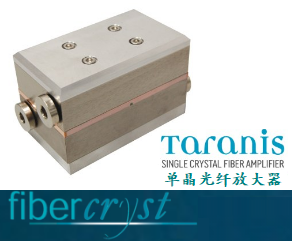公司简介
美国Calmar laser公司成立于1996年,有着20年的超快光纤激光器的设计生产经验,是全球领先的稳健、紧凑的皮秒和飞秒光纤激光器供应商,并承接OEM、工业、医疗和科学应用的客户提供解决方案。
产品列表
Fiber-Based ps and fs Lasers
Calmar picosecond and femtosecond lasers set the standard for high reliability and outstanding performance.
Femtosecond Lasers
High Pulse Energy Fiber-Based Picosecond and Femtosecond Lasers (FLCPA Series) - For clean, high speed laser ablation of tissue, CIGS, silicon, or other materials, without thermal damage to the substrate.
Up to 30 µJ pulse energy @1030 nm
Up to 3 µJ pulse energy @1550 nm
Adjustable pulse width 370 fs - 30 ps
Selectable repetition rate
Optional pulse compression to < 100 fs
Compact Fiber-Based Femtosecond Lasers (CFL Series) - - Fiber delivered compact laser head for industrial, scientific, and biomedical applications including multiphoton microscopy and laser spectroscopy.
13 nJ pulse energy @ 780 nm
50 nJ pulse energy @ 1550 nm
< 100 fs pulse width
Ultra-compact fs laser head
Pulsed Femtosecond Lasers / Seed Lasers (FPL Series)
0.5 - 100 mW average power for most fs laser models
0.1 - 10 ps pulse width for most fs laser models
10 - 100 MHz repetition rate for most fs laser models
Available in 780 nm, 805 nm, 1030 nm, 1064 nm and 1550 nm
Other ps and fs Lasers, Amplifiers, and Accessories
High Repetition Rate Fiber-Based Picosecond Lasers (PSL Series) - Actively mode locked ps laser, up to 40 GHz picosecond pulses.
20 mW average power
0.8 - 10 ps pulse width available
5 - 40 GHz tunable repetition rate available
Tunable wavelength and pulse width available
Femtosecond Optical Parametric Amplifier(FLOPA Series)
> 200 nJ pulse energy
< 200 fs pulses with MHz repetition rates
1300 nm or 1700 nm
Optical Fiber Amplifiers (AMP)
Optimized for short pulse amplification
Minimum nonlinear dispersion effects
15 to 37 dBm output power available
Polarization maintaining or non-PM fiber available
Bit Rate Multiplier
Pulse Compressor
技术能力
Calmar has 20 years of experience in commercializing new ultrafast fiber laser technologies. The unique fiber optic technology platform enables Calmar to produce highly reliable products with high performance in terms of short pulse width, high peak power, compact and excellent beam quality.
Fiber lasers have a gain medium based on a doped fiber structure. In a fiber, light does not suffer diffraction and is guided through a robust waveguide. The fiber laser components have been engineered to pass very stringent industrial standards. This gives a fiber laser advantages in term of high reliability, high efficiency, and compactness.
The Advantages of Fiber Lasers
Fiber lasers use the same rare earth doped glass as high power solid state lasers in free space. Both types tend to use diode lasers to pump a rare earth ion such as Erbium, Neodymium, or Ytterbium, which can store the energy for milliseconds until stimulated out by the optical laser power. However, fiber lasers tend to be more stable as they have no bulk optics on mounts that can misalign or drift over time or with temperature. The fiber can achieve more optical gain from the long length. Cooling through the thin fiber leads to efficient simple air cooled systems. The fibers can be wound into a small spool for compact modules with high power and sophistication.
At higher powers and pulse energies, the fiber is affected by very high optical intensity due to the small diameter beam. Thus effects such as Self Phase Modulation and Raman Scattering can dominate laser performance and limit the capability of the laser. Several methods to reduce the effect of high intensity nonlinearities include stretching the pulse out in bandwidth or time. Calmar is experienced at handling these effects while still giving all the advantages of stable long term performance and compact size from an optical fiber.
Calmar’s Technology
Calmar has developed four unique ultrafast fiber laser technologies
Passively Mode-locked Femtosecond Fiber Lasers
These fiber lasers use Er or Yb doped fiber as a gain medium and a semiconductor saturable absorber for passively inducing mode-locking. The output pulse widths are from picoseconds to femtoseconds with very low timing jitter. Calmar’s patented technology enables making a 10-100MHz oscillator for femtosecond and picosecond pulses in a very compact form.

Actively Mode-locked Fiber Lasers
These fiber lasers use Er or Yb doped fiber as gain medium and an electro-optics modulator for actively inducing mode-locking. They produce picoseconds to femtosecond pulse widths with very low timing jitter. Due to low noise nature of fiber gain medium, the actively mode-locked fiber laser use harmonically mode-lock lasers to produce stable output in a wide range of repetition rate , from several MHz to 50 GHz or even higher.

Fiber Amplifiers
Calmar has developed compact fiber amplifiers to amplify ultrashort high peak power optical pulses. We have developed the expertise to minimize the effects of Self Phase Modulation (SPM), Raman and chromatic dispersion.
Chirped Pulse Amplifiers
To reach higher output energy per pulse for ultrafast optical applications, Calmar uses the technique of Chirped Pulse Amplification. The optical pulse is stretched by chirping (spread out in time by frequency) to a longer duration before entering the high power amplifier. This pulse stretch minimizes the peak optical power and greatly reduces unwanted nonlinear optical effects for a given pulse energy. After the optical pulse reaches high power, the chirp is removed by linear recompression of the stretched pulse to an ultrashort pulse.
应用领域
Application Matrix
| Application | Cazadero High Pulse Energy Femtosecond Laser (FLCPA) | Carmel Compact fs Laser (CFL) | Mendocino Femtosecond Laser (FPL) | Eureka Picosecond Laser (PSL) |
|---|---|---|---|---|
| BIOMEDICAL | ||||
| Biophotonics | X | X | X | |
| Multi-photon Imaging (MPI) | X | X | ||
| Medical therapeutic surgery | X | X | X | |
| Optical Coherent Tomography | X | X | ||
| LASIK corneal flap creation | X | |||
| Catraract surgery | X | |||
| Cancer diagnostics | X | X | ||
| Skin cutting and planting | X | |||
| Wound healing | X | |||
| MICROELECTRONICS PROCESSING | ||||
| fs laser scribing of LEDs (sapphire, GaAs, GaN) | X | |||
| Materials characterization | X | X | X | X |
| Laser ablation of LED substrates (Laser Lift Off) | X | |||
| Memory repair | X | |||
| Silicon wafer ps laser scribing | X | |||
| Low K dielectric laser ablation | X | |||
| Die attach film (DAF) cutting | X | X | ||
| Flat panel display repair (FPD) | X | |||
| Marking/Engraving | X | |||
| SOLAR CELL PROCESSING | ||||
| Thin film femtosecond laser scribing | X | |||
| Anti-Reflective Coating (ARC) laser ablation | X | X | ||
| CIGS ps laser scribing | X | X | ||
| SCIENTIFIC RESEARCH / ENGINEERING R&D | ||||
| Terahertz radiation | X | X | ||
| Seed for high power lasers | X | X | X | X |
| Ti:Sapphire oscillator | X | |||
| Optical metrology | X | X | X | |
| Multiphoton microscopy | X | X | ||
| Nano-science | X | X | X | |
| Nonlinear optical studies | X | X | X | |
| Spectral comb | X | X | ||
| Short pulse amplification | X | |||
| COMMUNICATIONS | ||||
| Telecommunication components characterization | X | X | ||
| 100 GHz Ethernet | X | |||
| Optical clock for 50 – 200 GHz OTDM system | X | |||
| Transmission network characterization | X | |||
| DWDM metro network | X | |||
| Optical switching | X | X | ||
| Optical high speed sampling | X | X | ||














